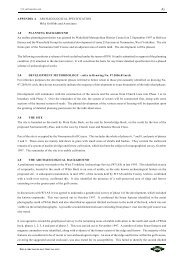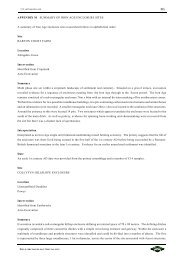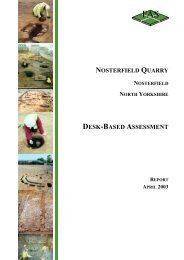ARCHAEOLOGICAL EVALUATION - Mike Griffiths and Associates
ARCHAEOLOGICAL EVALUATION - Mike Griffiths and Associates
ARCHAEOLOGICAL EVALUATION - Mike Griffiths and Associates
You also want an ePaper? Increase the reach of your titles
YUMPU automatically turns print PDFs into web optimized ePapers that Google loves.
FAS_lbf01.wpd 3<br />
1.3 AIMS AND OBJECTIVES<br />
The primary objective of the evaluation was to identify, characterise, <strong>and</strong> assess any archaeological remains<br />
within the proposed extension to Nosterfield Quarry, in order to establish the archaeological potential of the<br />
application area. The evaluation comprised a staged investigative programme, wherein the results of the early<br />
stages were used to inform the detailed design of subsequent stages of investigation. The scheme of evaluation<br />
consisted of both non-invasive <strong>and</strong> invasive investigations, which commenced with a review of existing<br />
information, <strong>and</strong> was followed by fieldwalking, an auger <strong>and</strong> topographic survey, geophysical survey, <strong>and</strong><br />
culminated in test pitting, h<strong>and</strong>-excavated trenches <strong>and</strong> machine excavated evaluation trenches.<br />
The purpose of the evaluation was to gather sufficient information to enable informed planning decisions, <strong>and</strong><br />
the formulation of an appropriate archaeological mitigation strategy for the proposed extension of s<strong>and</strong> <strong>and</strong><br />
gravel extraction at Nosterfield Quarry. The evaluation sought to provide the necessary information, while<br />
minimising damage to the archaeological resource, particularly in light of the significant quantity of information<br />
available from the archaeological investigation at the existing quarry.<br />
2.0 <strong>ARCHAEOLOGICAL</strong> AND HISTORICAL BACKGROUND<br />
Ladybridge Farm is situated within a l<strong>and</strong>scape known to have been intermittently occupied <strong>and</strong> exploited in<br />
a wide range of ways during prehistory, <strong>and</strong> in subsequent periods to the modern day (Figure 2). The site lies<br />
to the north of the henges <strong>and</strong> barrows of Thornborough, which have prompted study <strong>and</strong> interest in this area<br />
since the 19th century. Consideration of the archaeological <strong>and</strong> historical background to this project, therefore,<br />
focusses primarily on the prehistory of the area, <strong>and</strong> the evidence for occupation <strong>and</strong> activity from the<br />
Mesolithic to the Iron Age. However, there is also a need to consider the later use of the l<strong>and</strong>scape, since<br />
medieval agriculture, post-medieval enclosure, <strong>and</strong> modern activities, have all impacted on the remains of earlier<br />
activity, <strong>and</strong> shaped the l<strong>and</strong>scape <strong>and</strong> the archaeological resource as it exists today.<br />
2.1 PALAEOLITHIC AND MESOLITHIC (c.250,000BC - c.8000BC) (c.8000BC - c.4500BC)<br />
Typically for this period of prehistory, there is very little evidence for Palaeolithic <strong>and</strong> Mesolithic activity in<br />
the Nosterfield area. The finds of flints in peat samples extracted at the Nosterfield Quarry reveal the potential<br />
for early lithic remains (Berg 1991), <strong>and</strong> since then, programmes of fieldwalking have allowed some conclusions<br />
to be drawn concerning human activity in the area during this period.<br />
Fieldwalking undertaken as part of the Vale of York/Vale of Mowbray Neolithic L<strong>and</strong>scape Project revealed<br />
some limited evidence for later Mesolithic <strong>and</strong> early Neolithic activity in the l<strong>and</strong>scape surrounding Ladybridge<br />
Farm (Harding 1994; 1998, 36-7) (Figure 3). These finds were identified throughout the area under study, <strong>and</strong><br />
showed no notable concentrations that may have been indicative of occupation sites. A series of Mesolithic<br />
artefacts was recently recovered from excavations of a later Neolithic or Bronze Age burial monument, close<br />
to the Thornborough henges, including three microliths, an opposed platform blade core, a bladelet core <strong>and</strong> ten<br />
bladelets (Harding <strong>and</strong> Johnson 2004d, 16). This may provide stronger evidence for Mesolithic activity in the<br />
immediate area.<br />
FIELD ARCHAEOLOGY SPECIALISTS







